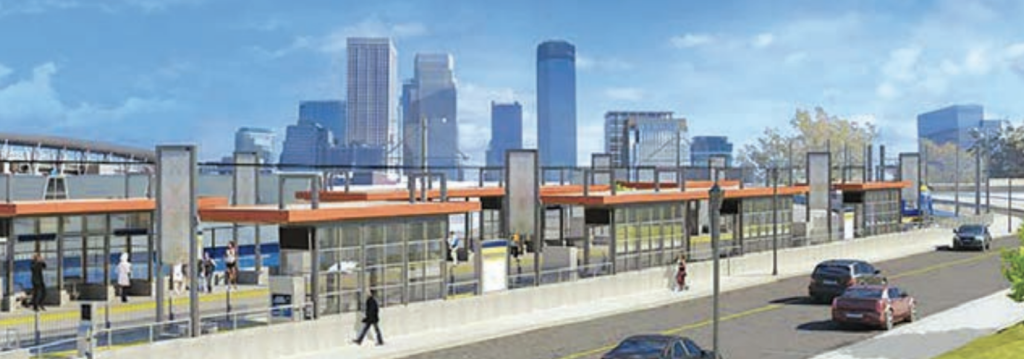An ‘air of inevitability?’
The Met Council admits it has not won the argument.
Governor Dayton upped the ante over the summer to secure funding for Southwest Light Rail Transit (SWLRT). Met Council Chair Adam Duininck was replaced by a more serious hire: Alene Tchourumoff. The only thing they have in common are names that are hard to spell and pronounce.
Unlike her predecessor, Tchourumoff has some private and public sector experience in infrastructure. Presumably she understands what the Federal Transit Administration (FTA) needs before it will cut Minnesota a check for $928 million. So where does the $2 billion project stand?
I was a bit reluctant to make predictions in late August for the fall issue of this magazine. But having watched the Council for many years, I am hopeful that the FTA will keep SWLRT on hold.
Between the editorial board at the Star Tribune, and TV and radio reports that simply repeat Met Council talking points, the project has an air of inevitability. For example, last spring the news was that the project received $10 million from Congress. In August, the news was that key freight agreements had been reached. Each time, the headlines blared triumphantly that the Council could now ask for “free” federal money.
In other words, it is useless to resist.
Admittedly, the relentless media campaign has been very successful. Ask the average metro resident and they think SWLRT will relieve congestion and reduce greenhouse gases. They also think someone else is going to take the LRT so they can get to work faster in their car.
The Center and a metro-wide coalition of elected officials and citizens have resisted SWLRT from the start because it is not just a colossal waste of money. It is Exhibit A for all that is wrong with the Council’s undemocratic governance structure and broad scope of authority.
The Center has doubled-down with a new congestion project; we will not give up until we get good transportation policy focused on congestion relief.
And it is making a difference.
Even Hennepin County Commissioner Peter McLaughlin, the man who has done more to impose light rail on the metro area than anyone, admitted that, “It’s going to be a pitched battle with the Center of the American Experiment…We have not won the argument.”
This is why Tchourumoff told MPR, “I think part of what my role is really going to be is about how to develop relationships across the region, and collaborate better; enhance the dialogue.”
Not only have McLaughlin and the Council not succeeded in convincing the Legislature to fund capital or operating costs, but SWLRT has been idling at the FTA in the engineering phase.

Moreover, there was an election in 2016, and it may as yet have consequences. By the time you read this, three big things are expected to move forward that should determine whether SWLRT is built or mothballed. What are they?
First, state legislators told U.S. Transportation Secretary Elaine Chao that SWLRT did not have their support and asked her to deny funding. The request was vigorously backed up by Congressman Jason Lewis (MN–2) who sits on the transportation committee. As of late August, the Republican congressional delegation from Minnesota has not weighed in as a group.
The FTA responded with a letter outlining several items to be completed before the project would be eligible for federal funding:
1. Obtain all local funding commitments to pay for the capital construction of the project;
2. Provide a complete 20-year financial plan that demonstrates the ability to continue to operate, maintain, and rehabilitate the existing transit system; and
3. Complete critical freight rail agreements (that then must be approved by the Federal Transportation Safety Board).
The Legislature did allow Hennepin and Ramsey Counties to raise taxes for transit. Instead of building the best bus transit in the country, the Council plans to pour the funds into several light rail projects, starting with SWLRT. The Met Council’s 2040 plan calls for spending $6.9 billion on “transitways,” but only $700 million on increasing road capacities.
The Center found that despite a massive capital investment in transit since 1996, ridership has remained flat; light rail does not attract new riders—it simply replaces bus riders. What does drive ridership is an increase in the price of gas. The return on LRT investment is very poor indeed, yet even key members of the business community support light rail either because they are profiting from the projects or have bought the argument that LRT will deliver congestion relief despite all evidence to the contrary.
The Council updated its 20-year financial plan with the FTA in June to reflect its newly-won tax revenue. That may take care of the first two FTA requirements. But when I met with the FTA last June, officials made it clear that the existing system (The Green and Blue LRT) must be maintained in a “state of good repair” before the FTA will support extensions like SWLRT.
The Council’s transit program is already running a structural deficit so large ($89 million) that the Legislature only gave the Council one-time money pending the outcome of an audit. The report from the Office of Legislative Auditor was due in August but apparently the Council’s accounting methods are so opaque that the auditor had to delay the report.
If the Council convinces the FTA that it meets eligibility requirements, it would explain why light rail projects are in fiscal trouble all over the country.
One freight agreement could slow this train down: The BNSF freight line is engineered to “co-locate” with SWLRT from the Bryn Mawr station to the Farmers Market. Without consulting Minneapolis elected officials, the Council agreed to build a massive reinforced-concrete safety wall: 3 feet thick, 10 feet high and over a mile long. When officials, caught by surprise, objected, they were summarily dismissed by Chair Tchourumoff. Will Minneapolis defy the Council and attempt to block this wall? If co-location is unsafe, maybe the residents of Hopkins or St. Louis Park should ask why the six miles of co-located track in their towns does not have the same protection.

I said there were three big things to watch. After the FTA requirements, the second is a federal lawsuit brought by the Lakes and Parks Alliance of Minneapolis. The Alliance has done what most citizens never do: spend their own funds to protect a peaceful, iconic park and recreation area. The City and governor were deaf to their pleas. Their case is scheduled to go to trial this fall; may they prevail in obtaining an injunction and legal fees. Unfortunately, the FTA told me the suit is irrelevant to their “eligibility” analysis but if the Council must go back to the drawing board on the route, that could kill the project.
The third and most important thing to watch is Congress. Remember that letter from the FTA? It said the president would direct the FTA to only fund projects with existing full-funding grants— projects like SWLRT would have to relyexclusively on local funding. No more “free” federal money.
But Congress appropriates money, not the president. By the time you read this, Congress may have passed an appropriations bill for 2018. It has not pulled this off in years, instead passing continuing resolutions. But there is hope. In July, the House appropriations committee followed the president’s lead: there was zero money for new LRT projects. The Senate version had a lot more money but not enough to cover all the projects teed up at the FTA.
But my conversations with staffers in D.C. are discouraging. Despite the promise of new fiscal discipline, I was told to expect the money to be appropriated for SWLRT in the Senate. Then it goes on to conference committee. Congress is not allowed to “earmark” anymore but everyone knows what projects members want when it appropriates a certain amount for transit.
Sen. Amy Klobuchar is leading the fight for SWLRT. Her party did not win in 2016 but unfortunately Sen. Susan Collins from Maine is the transit subcommittee appropriations chair. So, folks, it is up to the U.S. House, the holder of the nation’s purse strings, to hold the fiscal line.
If Congress ends up appropriating enough funds to cover SWLRT, it is still possible that Secretary Chao, who is considered one of the only fiscal conservatives in D.C., will deny SWLRT funding.
Southwest Light Rail Transit is an example of how “free” federal money inspires boondoggles and crony capitalism. It is an extreme example because the Met Council’s governance structure is so unaccountable that even DFL officials are not consulted on projects in their own backyard.
The irony is that if Chair Tchourumoff gets funding for SWLRT by continuing to run roughshod over DFL officials, the Center’s ideas for an orderly breakup of the Met Council will get a more bipartisan reception next session.